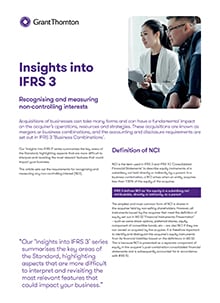

Acquisitions of businesses can take many forms and can have a fundamental impact on the acquirer’s operations, resources and strategies. Our ‘Insights into IFRS 3’ series summarises the key areas of the Standard with this article setting out the requirements for recognising and measuring any non-controlling interest (NCI).
In this article Recognising and measuring non-controlling interestsThis article sets out the requirements for recognising and measuring any non-controlling interest (NCI).
Download PDF [261 kb]
NCI is the term used in IFRS 3 and IFRS 10 ‘Consolidated Financial Statements’ to describe equity instruments of a subsidiary not held directly or indirectly by a parent. In a business combination, a NCI arises when an entity acquires less than 100% of the equity of the acquiree.
The simplest and most common form of NCI is shares in the acquiree held by non-selling shareholders. However, all instruments issued by the acquiree that meet the definition of equity set out in IAS 32 ‘Financial Instruments: Presentation’ – such as some share options, preferred shares, equity component of convertible bonds, etc – are also NCI if they are not owned or acquired by the acquirer. It is therefore important to identify and distinguish the acquiree’s equity instruments from its financial liabilities based on the definitions in IAS 32. This is because NCI is presented as a separate component of equity in the acquirer’s post-combination consolidated financial statements and is subsequently accounted for in accordance with IFRS 10.
Depending on the nature and the rights those equity instruments entitle their holders, NCI can be grouped into two broad categories, which in turn determine the available measurement options at initial recognition. Determining whether a NCI measurement option is available is key when accounting for a business combination, since the measurement of NCI can affect the amount of goodwill and subsequent accounting.
| Category | Description | Measurement option |
| Present ownership instruments | Acquiree’s shares held by non-selling shareholders that are present ownership interest and entitle them to a proportionate share of the acquiree’s net assets in the event of liquidation (eg common or ordinary shares). | Measured either at fair value (fair value model) or proportionate share of recognised amount of assets and liabilities of the acquiree (proportionate interest model). |
The choice between the two measurement options is to be made for each business combination on a transaction-bytransaction basis, rather than being a policy choice applicable to all business combinations.
These measurement options are only available on initial recognition of a NCI, as part of a business combination transaction, in order to determine the amount of goodwill. Once initially recognised in accordance with IFRS 3, IFRS 10 guidance on subsequent accounting should be applied.
The basis on which NCI of which are present ownership instruments is initially measured, affects goodwill at the acquisition date but could also have a financial impact on subsequent impairment and transactions with those NCI. When the fair value model is used, 100% of the goodwill in the acquiree is recognised (both the acquirer’s and the NCI’s share). This is sometimes described as the full goodwill model. Under the proportionate interest model only the acquirer’s interest in the goodwill is recognised (a lesser amount).
The following example shows the basic effect of the two models:
Example – Measuring NCI
Entity A pays CU800 for an 80% interest in Entity B. Entity A does not have any previously held equity interest in Entity B. The fair value of Entity B’s identifiable net assets is estimated to be CU750. Using a valuation technique, the fair value of the remaining 20% in Entity B (the NCI) on the acquisition date is determined to be CU180. The NCI gives right to a present ownership interest in the acquiree’s equity.
Analysis
The amount of NCI and goodwill recognised under the alternative methods is as follows:
| Fair Value Model CU | Proportionate interest model CU | |
| Cash consideration | 800 | 800 |
| NCI at fair value | 180 | - |
| NCI at 20% of identifiable net assets* | - | 150 |
| Total | 980 | 950 |
| Fair value of 100% of identifiable net assets | 750 | 750 |
| Goodwill | 230 | 200 |
| Recognised amount of NCI | 180 | 150 |
| * The proportionate share of NCI in the identifiable net assets is determined as follows: CU750 * 20 % = CU150. | ||
Apart from the effect on goodwill, other factors may influence the measurement model choice, download 'Recognising and measuring non-controlling interests' for more.
Fair value of NCI should be measured in accordance with IFRS 13 ‘Fair Value Measurement’. Refer to our article Insights into IFRS 3 – How are the identifiable assets and liabilities measured? which provides some guidance on how to determine fair value in accordance with IFRS 13.

IFRS 3 provides however some guidance on how the fair value of NCI is determined when applicable:
Fair value of NCI
The acquirer may arrange with non-selling shareholders during the period of negotiation for the acquisition to acquire NCI shares after the acquisition date – eg by entering into put or call options or a forward contract over the remaining shares held by the non-selling shareholders of the acquiree. An analysis is then required to determine whether, in substance, the underlying shares still legally owned by the NCI are economically attributable to non-selling shareholders or to the acquirer. This analysis and its consequences on the acquisition accounting is discussed further in our article Insights into IFRS 3 – Determining what is part of a business combination transaction.
We hope you find the information in this article helpful in giving you some insight into IFRS 3. If you would like to discuss any of the points raised, please speak to your usual Grant Thornton contact or your local member firm.